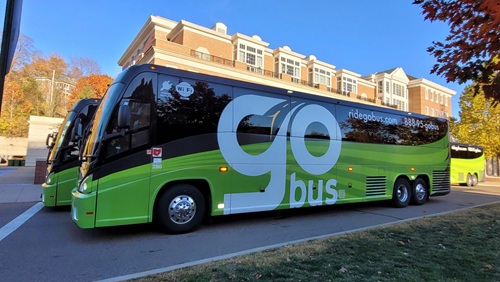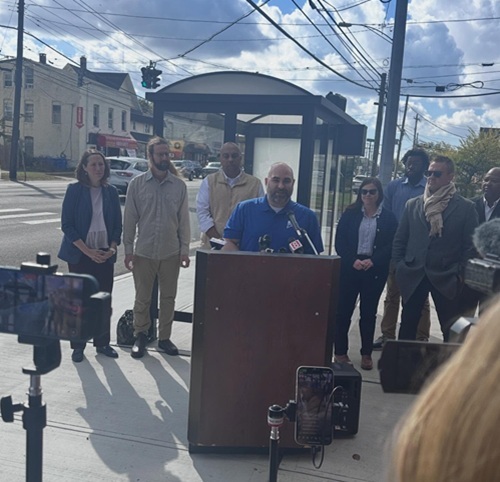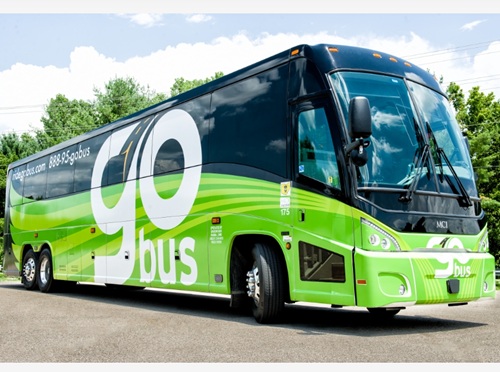The Ohio Department of Transportation, the Maine Department of Transportation, and the Connecticut Department of Transportation (CTDOT) all recently finalized key transit investments for their respective regions.
[Above photo by the Ohio DOT]
Ohio DOT, in partnership with the Hocking-Athens-Perry Community Action Program or “HAPCAP,” recently expanded the state’s “GoBus” intercity transit network – significantly increasing mobility options for rural communities and strengthening statewide connectivity.

Through this investment, Ohio DOT will fund four new intercity bus routes designed to extend GoBus service into previously unserved regions of the state. The expanded service will connect thousands more Ohioans to essential services, higher education, and employment opportunities.
The upcoming expansion will double the service footprint, extending routes to Western and Northern Ohio, including communities such as Bowling Green, Fremont, Marion, Middletown, Oxford, Upper Sandusky, and Yellow Springs.
GoBus operates with deluxe 56-passenger motor coaches featuring free wireless internet, outlets at every seat, extra leg room, on-board restroom, and a seat belt at every seat.
“By expanding GoBus routes into more communities, we’re helping Ohioans connect to jobs, healthcare, and education no matter where they live,” said Ohio DOT Director Pamela Boratyn in a statement.
Meanwhile, the Maine DOT joined with the Maine Turnpike Authority (MTA), the Town of Scarborough, and Greater Portland Metro (GPM) to create a new partnership that will bring enhanced public transit service to Scarborough, ME.

The initiative marks a significant step toward improving regional mobility, reducing traffic congestion and expanding sustainable transportation options in southern Maine. Once complete, GPM will provide new fixed-route transit service between Scarborough and Portland centered along the U.S. Route 1 corridor – the first such project in Maine.
MTA has approved a $3.5 million appropriation over five years to support this initiative, which aligns directly with Maine DOT’s State Transit Plan recommendations to increase transit service, and to explore, pilot and implement programs to address the needs of underserved populations, as well as to leverage funding and partnerships to improve public transportation in the region.

That complements $1.3 million in Federal Transit Administration funding previously awarded by GPM to the Portland Area Comprehensive Transit System to support the new service. Along with Scarborough’s commitment of local funding, that money will allow MTA to complete planning and launch new transit services that will connect Scarborough residents to medical facilities, shopping locations, regional employment centers, and other key destinations.
The expansion is also part of Maine DOT’s goal to facilitate the integration of numerous transit services, expand transit networks, and create a micro-transit option aimed at mitigating the first and last mile challenge faced by many transit systems.
“This represents a new collaborative era between Maine DOT, the MTA, and our transportation partners in how we utilize joint funding to best manage the transportation network” said Dale Doughty, Maine DOT’s acting commissioner, in a statement. “These projects are great examples of how partnerships between agencies can deliver more efficient and connected transportation options for more Maine people.”
Concurrently, CTDOT has embarked on the state’s first-ever installation of bus shelters under its new Bus Stop Enhancement Program or BSEP, beginning with five new shelters in Hamden, CT.

The BSEP is a $20 million initiative to upgrade high-ridership bus stops across Connecticut with modern amenities including shelters, benches, solar lighting, and real-time information displays. In total, 600 bus shelters will be installed by 2029.
Informed by rider feedback, this program directly addresses the most requested improvements, including shelter, seating, and improved access to real-time information, the agency noted.
“We’re transforming bus stops across Connecticut into more accessible, welcoming, and rider-friendly spaces because everyone deserves the best experience possible when using public transit,” added Garrett Eucalitto, CTDOT commissioner, who also serves as the 2024-2025 president of the American Association of State Highway and Transportation Officials.
“These new shelters are a vital investment in dignity, comfort, and safety for the tens of thousands of people who rely on our bus system every day,” he said in a statement.
 States
States
Master Plan Map Completed for Utah Trail Network
October 31, 2025 States
States

